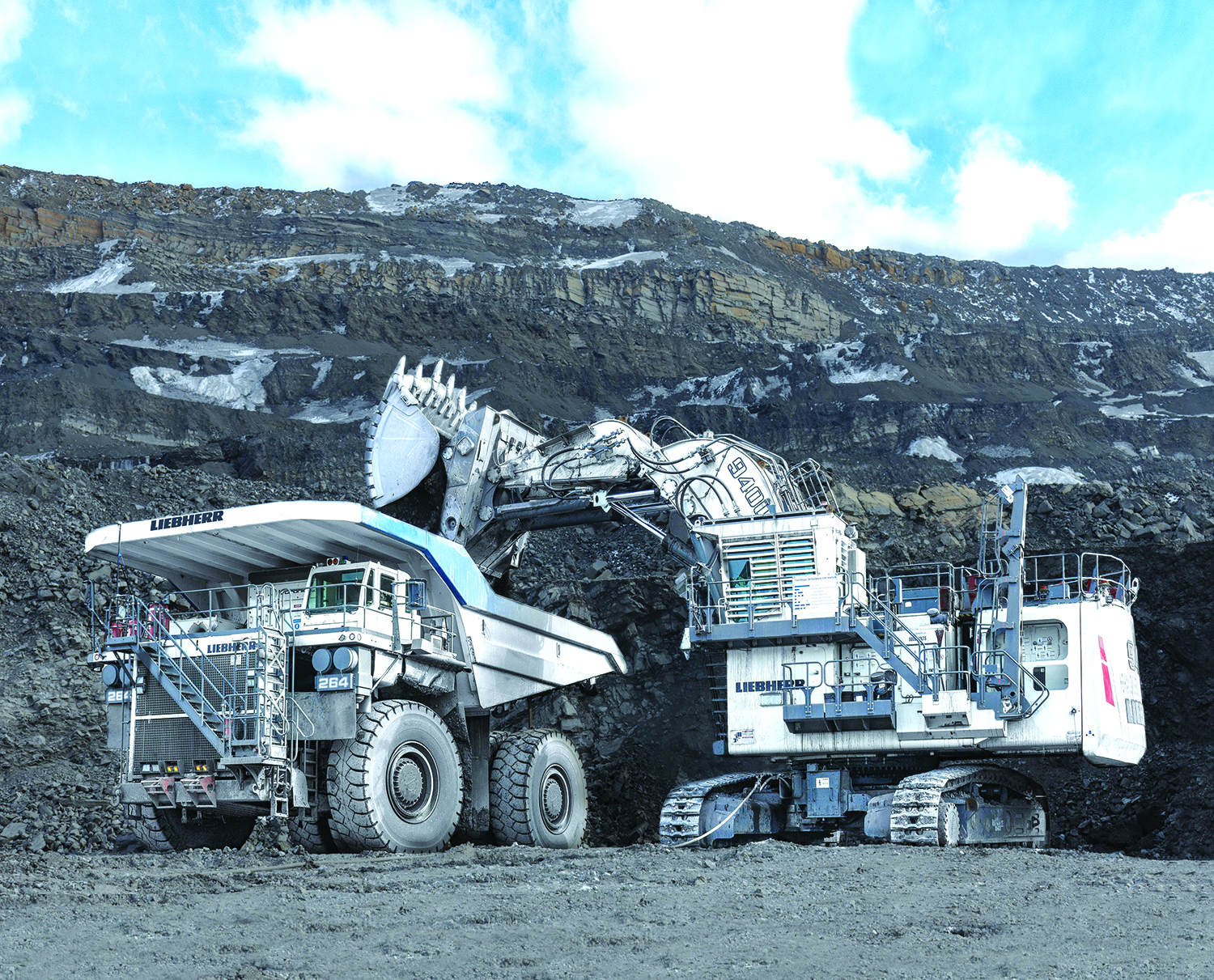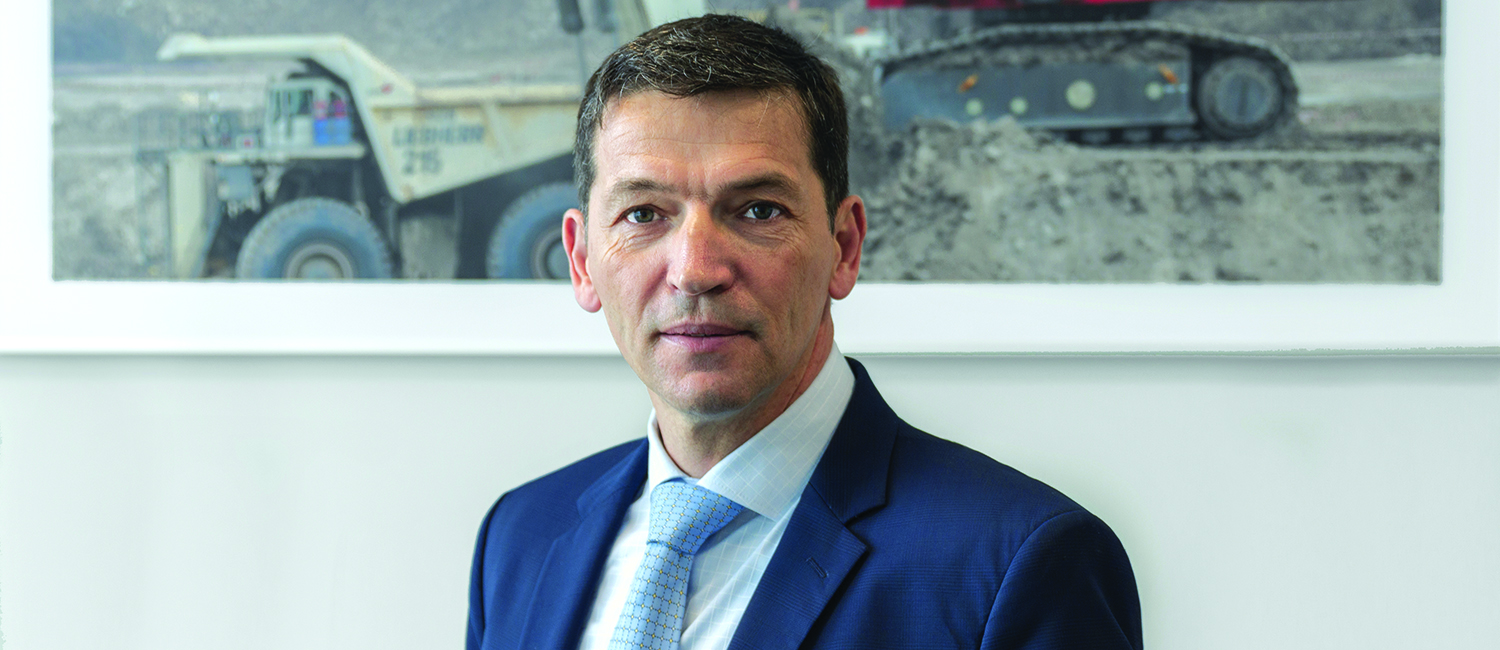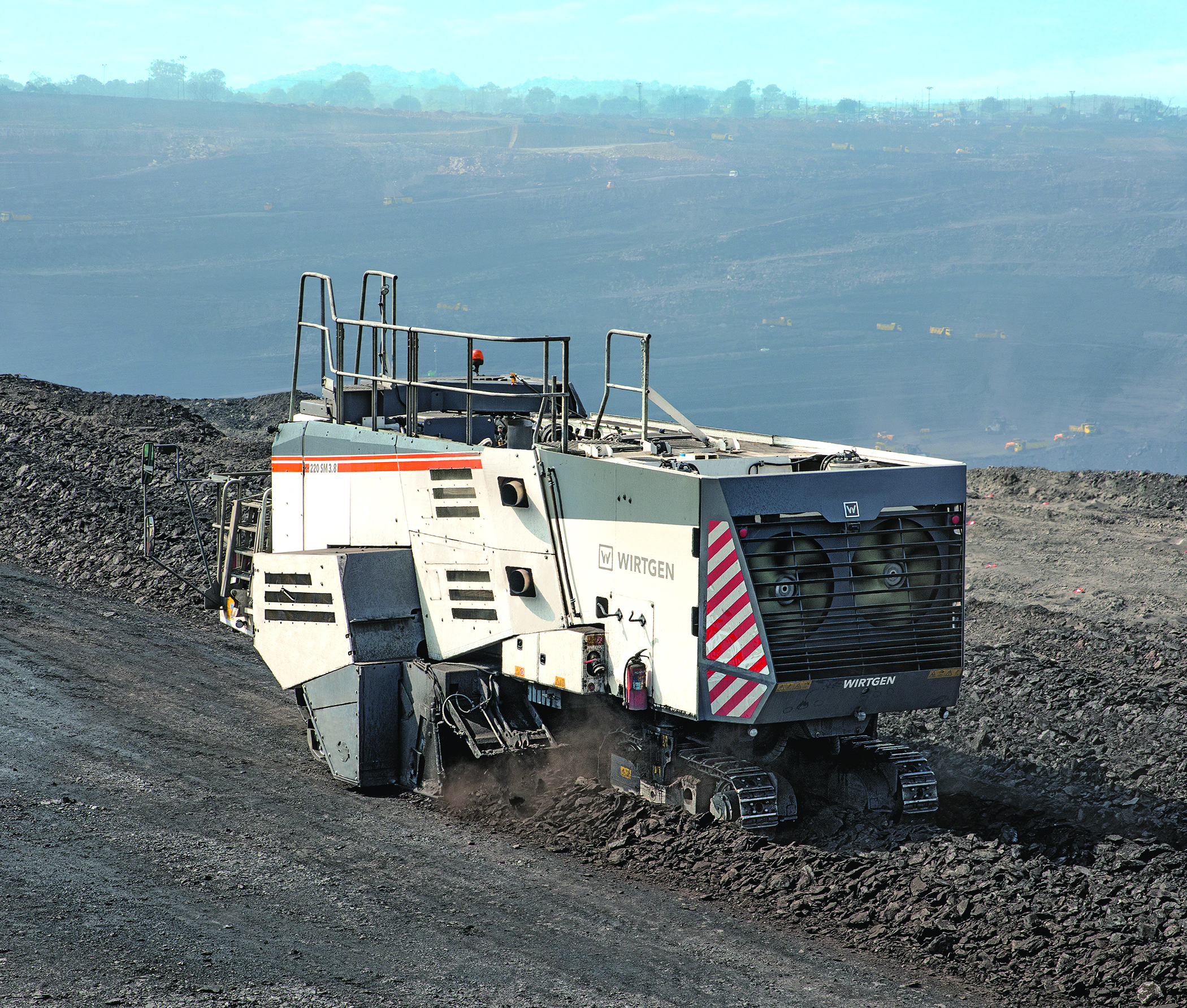
Liebherr is working to offer electric versions of its full hydraulic excavator range. (Photo: Liebherr)
The mindset that relied on economies of scale has now shifted to mining smarter
Most mined commodities are recovered using open-pit mining methods. Oftentimes, these activities take place in remote locations in extreme conditions that could range from high-altitude arctic to high-temperature arid deserts. To mine year-around in these conditions requires dedication and robust equipment that operates for extended periods of time.
More recently, mining operations in general have been moving toward automated and operator-assisted systems that improve the loading and cycling of haul trucks as well as the productivity of the primary excavation tools.
Liebherr Looks to the Future With Intelligent, Integrated Technologies
Dr. Jörg Lukowski, vice president at Liebherr Mining, shared his observations on the global mining market. “Some mining operations were placed on hold due to COVID-19 in the first and second quarter of 2020, particularly in the African and South American markets, while other markets like Oceania and Asia have come through the crisis surprisingly well,” Lukowski said. “Following some supplier lockdowns and logistic restrictions, we took appropriate measures and were able to keep the incoming supply chain and factory production capacities stable with only some small adjustments. Thanks to our service support network of Liebherr-owned affiliates and third-party service providers, we were able to continue providing a very high level of service support throughout the year.”
In 2020, Liebherr successfully commissioned and handed over several ultra-class units — both hydraulic excavators and trucks — in Australia and South America, as well as a considerable number of midsized machines in West Africa and Asia.
Liebherr recently launched its large D98 diesel engine, which can be used to power its mining equipment. “To further integrate our engines and mining products, Liebherr is offering in-house designed and manufactured engines for two-thirds of its mining machine portfolio,” Lukowski said. “Liebherr has two engine manufacturing facilities, one in Bulle, Switzerland, developing and manufacturing the D95 and D96 series engines, and the other one in Colmar, France, where we develop and manufacture the D98 series engines.”
The D95 series engines have a long history and are used in many different Liebherr products (excavators, dozers, wheel loaders, cranes, etc.) and applications (maritime, power generation, etc.). Liebherr D95 engines meet the different requirements for exhaust emission regulations across the globe — “stage” for Europe, “tier” for the U.S./EPA and “IMO” for marine installations.
“The D98 series engines have been launched in recent years in power generation applications. Currently, we are integrating the D98 engine into our mining machine portfolio steadily and strategically,” Lukowski said. “We are planning to have the Liebherr D98 available until 2025 for the majority, if not all of our ultra-class trucks, and large and ultra-class hydraulic excavators.”
Liebherr is well-known for its cranes and the company recently added the HS 8300.1 dragline to its line of mining equipment. It is a small mining dragline — one that is easy to mobilize and relocate, due to a fast-track installation process. “Thanks to our standardized production process, the HS 8300.1 has much shorter delivery times than the larger draglines in our industry, with easy and quick maintenance,” Lukowski said. “We currently have a test unit in operation in a bauxite mine in Brazil. The machine has shown some promising results and the potential to reduce the total operating cost for the mine.”
Liebherr celebrated the delivery of the 100th PR 776 dozer last summer. The PR 776 is the flagship of the Liebherr dozer factory, Lukowski explained. “Beyond the performance parameters, customers are very excited about the operator comfort and safety features the dozer delivers thanks to its 360° visibility with the rear-view camera, and ROPS/FOPS integrated in the cabin structure.”
The environmental requirements of North America (Tier 4) and Europe (Stage V) were crucial considerations for the PR 776. This 70-metric-ton (mt) dozer uses the proven Liebherr selective catalytic reduction (SCR) system for exhaust-gas treatment, and the machine relies upon the extreme efficiency of the hydrostatic transmission (as compared to traditional mechanical drive).
“This technology reduces the fuel burn rates and carbon footprint by 20% — a fact we have proven by testing it side-by-side with competitor machines in various operations and in a wide range of conditions,” Lukowski said.
Today, Liebherr Mining is the OEM that offers the largest range of electric-driven excavators on the market. Ranging from 130 metric tons (mt) to 800 mt; the R 9150 B, R 9200, R 9250, R 9350, R 9400 and R 9800 are all available as electric-driven versions.
Electric drive does not only apply to the range of Liebherr hydraulic excavators, but also the off-highway trucks. In fact, Liebherr was the first to develop a 100-mt diesel-electric mining truck with a four-corner oil-immersed braking system and active front-end technology. This truck is operating today in Austria and South Africa, reducing the costs per ton of these mining operations.
To further reduce operating costs, Liebherr offers a trolley-assist solution for its truck range. Using onboard pantographs to connect the truck’s drive system to overhead power lines on uphill haulage segments, the Liebherr Trolley Assist System improves efficiency and productivity. When connected to the overhead power lines in trolley mode, the full power capacity of the electric wheel motors can be translated into speed on grade while the diesel engine idles, reducing emissions and fuel consumption.
Since signing the development contract for the trolley system at bauma 2019, VA Erzberg has been testing the modified
T 236 diesel-electric truck in its siderite iron-ore mine in Eisenerz, Austria. The tests were conducted on a 500-meters (m)-long test segment that is now being extended to 5 km with the upper section at around 1,055 m above sea level. The benefit of this system is that it allows the truck to navigate around corners with a radius of only 12 m.
“We are also continuing our development of integrated mine automation solutions,” Lukowski said. “Our automation strategy is focused on providing our customers with flexible scope of supply solutions. Liebherr will provide a series of product offerings, capable of integrating at multiple levels to enable next generation mine automation. We’re looking forward to making some exciting announcements in that regard during the course of 2021.”
A major mining-related focus for Liebherr in 2021 will be the marketing and sales of its digital products and services. “We have developed some new innovative products, especially in the area of Assistance Systems — truck loading assistant, performance monitoring, application severity, bucket filling assistant — to support the overall operator performance and achieve a significant increase in productivity,” Lukowski said.
Read more at www.liebherr.com/en/gbr/products/mining-equipment/mining-equipment.html.
RWE: The Carbon Footprint Reduction Experts
By Arie-Johann Heiertz, head of mining and materials handling at RWE Technology International GmbH
Carbon footprint reduction is a major task for mining operators worldwide. RWE Technology International GmbH (RWE TI) is an international mining and power consulting firm that is looking especially for these companies. We have extensive experience both in operating low-carbon emitting equipment in large mining operations and in training others to achieve the same.
With more than 120 years of successful company history behind us, RWE TI has undergone fundamental changes and is now a leading supplier of renewable energy worldwide. In addition, we are the largest mine operator in Europe. With this unique combination, we operate large-scale, open-pit mines in Germany and run wind farms, solar power and battery-storage facilities in many countries around the world.
It is our philosophy to continuously improve. For instance, we are investing €5 billion in renewable energy by 2022 and are developing our hydrogen production projects at full speed, to name just a few activities. As a team, we have achieved a lot and we will continue on our path to create a sustainable future with climate neutrality by 2040; to be the best energy company we can possibly be.
Harnessing Electrification and Automation
RWE believes that major strides in carbon footprint reduction in mining can be achieved by the electrification of mining operations. In this respect, the use of continuous mining equipment like in-pit crushing and conveying (IPCC) technology is now proven under strict environmental and economic boundary conditions. This technology is an effective alternative mining solution when mass handling requirements become too expensive or environmentally unattractive for conventional transportation methods.
RWE TI itself has extensive experience with this technology as it operates three large open-cast mines in Germany — successfully and very economically, solely employing conveyor-based continuous mining and transport technology.
In total, our three operations boast the largest belt conveyor systems in the world with more than 250 km of mobile belt conveyors installed in rough mining terrain. More than 1.3 billion metric tons (mt) of product and overburden is handled annually, operating 24/7.
Industry leading planning, operation and maintenance know-how has been collected more than 70 years and can be made available to customers via our consulting and engineering services. And an additional benefit worth mentioning is that continuous mining also allows for a very high degree of automation.
Within the mining industry, RWE TI’s consulting and engineering services are well known. The first in-pit crusher was planned and installed at our client Vale’s northern iron-ore mine more than 30 years ago, shortening the trucking distance and haulage height significantly. Since then, a large number of clients — among them BHP, Antofagasta Minerals and Anglo American — rely on the planning, operation and maintenance experience and know-how derived from our German large-scale mines.
Another example of RWE TI’s engineering capabilities are the world’s strongest conveyors, which transport copper ore downhill in the Chilean Andes, producing surplus electricity as a byproduct.
Being an engineering consultant with real operator’s experience puts us in the position to provide tailor-made customer training in our own operations. This unique benefit was recognized by Vale, which asked us to train more than 80 of its managers, engineers and operators in RWE mines for multiple weeks each, enabling a common understanding of the differences between discontinuous truck and shovel mining and fully continuous mining.
The sustainable success of these training sessions can be seen at Vale’s flagship project S11D in Brazil, where the first fleet of fully mobile crushing units, connected to a network of mining conveyors, has been operating successfully for five years.
Nowadays, we are using our unique position as an international mining company fully integrated into a global leader for renewable energies to transfer this combined knowledge to our clients in the mining industry. Helping them to also be green, efficient and highly cost competitive.
To determine the feasibility and potential benefits of implementing an IPCC system at your operation, a number of key drivers need to be investigated, understood and interpreted correctly. A short questionnaire is available on the RWE TI website for download.
We are keen to assess the carbon reduction potential of your mine. The question is: are you ready to go for it?
Read more: www.group.rwe/en/bespoke-solutions/solutions-for-mining
Surface Miner Maximizes Output for Indian Coal Mine
India has extensive coal reserves and uses them as the country’s most important source of energy, covering about half of its primary energy needs with coal. One of the country’s largest coal operations, the Bhubaneswari coal mine, is located near the town of Talcher in the eastern Indian state of Odisha, where coal has been mined since the 1990s. The Indian company Bhubaneswari Coal Mines Ltd. (BCML) has operated the open-cast mine since 2011 and successfully uses Wirtgen surface miners.
Mining operations at the Bhubaneswari coal mine are conducted 24 hours a day to continually supply the nearby coal-fired power plants with the raw materials they need to generate electricity. As a result, the company mines more than 25 million metric tons per year (mt/y). The material is relatively soft with a compressive strength of up to 35 MPa. Instead of drilling and blasting, BCML uses Wirtgen surface miners to cut the soft rock.
Bairagi Sahu, associated vice president, BCML, commented on the fleet of seven Wirtgen 220 SM 3.8 surface miners that the mine employs. “When it comes to performance, the Wirtgen surface miners are simply the best on the market,” he said. “At our mine, we sometimes cut up to 1,800 mt/h of coal with one surface miner.”
The use of surface mining technology has a number of operational benefits. Firstly, it eliminates the need to store and handle explosives. The highwall provides enhanced slope stability and therefore fewer rockfalls. Surface miner technology eliminates the need to close the mine for blasting, which delays production. And, in addition, mine operators no longer need to spend time obtaining the required permits, hiring certified blasters or compiling the associated documentation.
Mining with Wirtgen surface miners also offers financial benefits. The flat surfaces created during the mining process serve as stable roadways that facilitate fast truck haulage. This increases the transport capacity of the entire truck fleet, and the quality of the road surface even reduces wear and tear to each truck’s tires, frame and suspension, allowing the operators to use standard trucks rather than off-the-road models. The resulting reduction in transport costs helps mining companies lower production costs per ton of material.
The only requirement for companies to fully leverage the benefits of surface mining is to use intelligent machines. The 220 SM 3.8, with an operating weight of 58 mt, is propelled by a robust Cummins diesel engine with an output of 708 kW. Thanks to high-pressure injection and intelligent engine management, the engine is extremely fuel-efficient.
At the same time, the diesel tank with a capacity of 2,300 l makes it possible to operate the machine around the clock with only one stop to refuel per day, resulting in high productivity. A cooling system with a demand-driven fan speed also helps to reduce fuel consumption and at the same time reduces noise emissions.
The 220 SM 3.8 is designed for mining all types of soft rock. The 3.8-meter-wide cutting drum features tall, narrow holder bases that ensure that the material flows smoothly while requiring minimal energy. In addition, the shape of the holders in combination with the arrangement of the cutting tools minimize the amount of fine material generated. The material is continuously deposited in a windrow directly behind the machine.
“With this mining method, we can clearly see the quality of the coal due to the difference in color between the coal and the light-colored overburden, allowing us to mine the material cost-effectively,” Om Prakash, chief operating officer at BCML, explained.
In open-pit mining, reliability and availability are key. All of the 220 SM 3.8’s components are designed for extremely demanding open-cast mining applications. For example, additional filters in all of the machine’s circuits and a pressurized hydraulic reservoir ensure maximum purity in the hydraulic system for smooth operations. The clean oil in turn extends the service life of the downstream components, which also contributes to higher machine availability. The components’ long service life and the miner’s minimal downtime ultimately result in greater productivity and cost-effectiveness.
The 220 SM 3.8’s standard ROPS-FOPS operator’s cabin features additional soundproofing and vibration isolation, allowing the operator to work with maximum focus for many hours without the risk of fatigue. The ergonomically designed and clearly arranged controls are integrated into the armrests of the driver’s seat, and all of the machine’s key functions are logically incorporated into the multifunctional joysticks. This means the operator can operate the machine intuitively in just a few steps and fully concentrate on high-precision mining.
For optimum visibility, the fully air-conditioned, spacious cabin features generously sized windows and is positioned so that the operator always has a clear view of the cutting edge. An optional camera system also gives the operator an excellent overview of the work area, even behind the machine. In short, ideal conditions for productive operations.
The 220 SM 3.8 is also designed to be easy to service and maintain. All of the maintenance and service points are easily accessible from the ground or inside. The walk-in engine compartment makes it possible to quickly and easily inspect the engine, and the machine’s air, fuel and hydraulic oil filters are also directly accessible. Ultimately, the intelligent maintenance concept also results in higher machine availability.
Read more: www.wirtgen-group.com/en-us/products/wirtgen/technologies/surface-mining/




